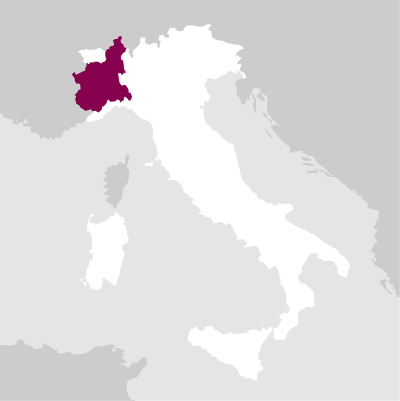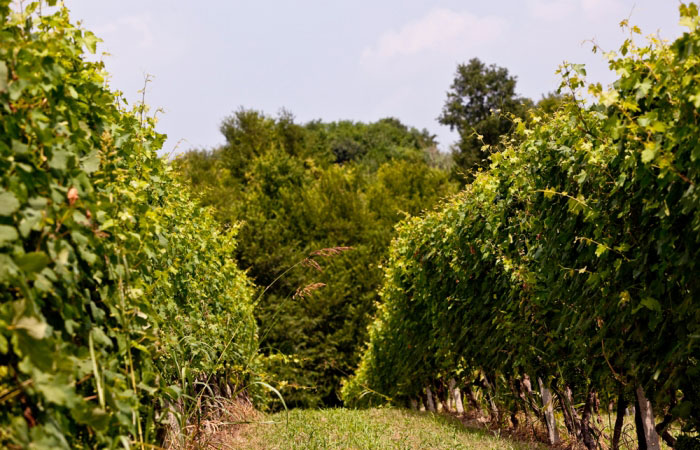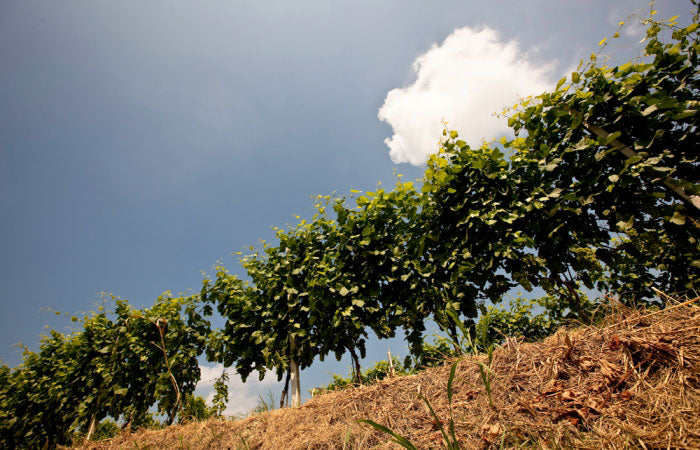Piedmont is one of Italy's most important wine-growing regions: it boasts no less than 52,000 hectares of land devoted to vines, with numerous wines that can boast DOCG and DOC status. It is a very old wine production dating back to the Greeks, who not only imported wine, but also started to cultivate their own vines there. Undoubtedly, this was helped not only by the soil consisting of sedimentary rocks, but above all by the continental climate characterised by cold winters and hot summers with significant temperature fluctuations that allowed the various grape varieties to flourish. Undoubtedly, the most important grape variety is Nebbiolo, also known as ' spanna ' in reference to an ancient method of cultivation called 'a spanna'. In addition to this vine, dolcetto, barbera, muscat, brachetto, malvasia, croatina, grignolino, uva rara and also international vines are of great importance. It is the Langhe area that represents the most important wine growing area, followed by Monferrato, Roero, Colline Tortonesi, Canavese, Colline Novaresi and Colline Torinesi. xtraWine dedicates a large section to typical Piedmontese wines, offering you the possibility to choose between fine Piedmontese red wines, sparkling Piedmontese wines or classic white wines, all of which have received important awards from Bibenda, Gambero Rosso, Veronelli and AIS. Among the wines on offer you can also choose from the best vintages dating back to 2012, 2013, 2014, 2015 and 2016 all from important producers such as: Marchesi di Barolo, Fontanafredda, Enrico Serafino, cantina Antinori, La Spinetta and Rocche Costamagna. As Piedmontese wines have a wide range of flavours depending on the sandy and clay soil, they can be paired with first courses, meat dishes, shellfish and desserts as they are able to enhance the aromas and flavours of each dish.
Wines of Piedmont: The best wines of Piedmont at unbeatable prices
No products found
Use fewer filters or remove all
Use fewer filters or remove all
-
 95 RPRobert Parker
95 RPRobert Parker
The prestigious international wine guide from the renowned Robert Parker, the world's most experienced and trusted wine taster.94 WSWine Spectator
Wine spectator is the most influential wine guide on the internet.94 JSJames Suckling
James Suckling is an influential American wine critic and journalist who worked at Wine Spectator for 30 years. He left the magazine in 2010 to start his own website and guidebook (JamesSuckling.com). He specialises in Italian and Bordeaux wines.14.5%Regular price CHF 29.00Regular price CHF 29.00 Sale price Unit price per -
 97 LMLuca Maroni
97 LMLuca Maroni
One of the most prestigious wine guides in Italy.4 VTVitae AIS
Italian Sommelier Association (AIS) guide3 GRGambero Rosso
This guide is highly respected and offers the most comprehensive review of Italian wines. It has a long tradition and is based on blind tastings carried out by over 100 experts.14.5%Regular price CHF 17.00Regular price CHF 17.00 Sale price Unit price per -
 93 JSJames Suckling
93 JSJames Suckling
James Suckling is an influential American wine critic and journalist who worked at Wine Spectator for 30 years. He left the magazine in 2010 to start his own website and guidebook (JamesSuckling.com). He specialises in Italian and Bordeaux wines.92 VOVinous
Vinous is the online guide from Antonio Galloni, one of the world's leading wine connoisseurs.14.0%Regular price CHF 32.00Regular price CHF 32.00 Sale price Unit price per -
 5.0%Regular price CHF 12.50
5.0%Regular price CHF 12.50Regular price CHF 12.50 Sale price Unit price per -
 12.5%
12.5%-14%
Regular price CHF 24.00Regular price CHF 24.00 Unit price perCHF 28.00List price: Indicates the price of the product before the start of the promotionSale priceSale -
 14.5%Regular price CHF 13.00
14.5%Regular price CHF 13.00Regular price CHF 13.00 Sale price Unit price per -
 15.0%Regular price CHF 17.50
15.0%Regular price CHF 17.50Regular price CHF 17.50 Sale price Unit price per -
 14.0%Regular price CHF 18.50
14.0%Regular price CHF 18.50Regular price CHF 18.50 Sale price Unit price per -
 93 JSJames Suckling
93 JSJames Suckling
James Suckling is an influential American wine critic and journalist who worked at Wine Spectator for 30 years. He left the magazine in 2010 to start his own website and guidebook (JamesSuckling.com). He specialises in Italian and Bordeaux wines.14.0%Regular price CHF 25.00Regular price CHF 25.00 Sale price Unit price per -
 13.0%Regular price CHF 13.50
13.0%Regular price CHF 13.50Regular price CHF 13.50 Sale price Unit price per -
 95 RPRobert Parker
95 RPRobert Parker
The prestigious international wine guide from the renowned Robert Parker, the world's most experienced and trusted wine taster.94 JSJames Suckling
James Suckling is an influential American wine critic and journalist who worked at Wine Spectator for 30 years. He left the magazine in 2010 to start his own website and guidebook (JamesSuckling.com). He specialises in Italian and Bordeaux wines.93 DEDecanter
Decanter is a wine and lifestyle magazine, published monthly in around 90 countries. The magazine includes industry news, classic guides and advice on wine and spirits.14.5%-8%
Regular price CHF 32.00Regular price CHF 32.00 Unit price perCHF 35.00List price: Indicates the price of the product before the start of the promotionSale priceSale -
 3 GRGambero Rosso
3 GRGambero Rosso
This guide is highly respected and offers the most comprehensive review of Italian wines. It has a long tradition and is based on blind tastings carried out by over 100 experts.91 JSJames Suckling
James Suckling is an influential American wine critic and journalist who worked at Wine Spectator for 30 years. He left the magazine in 2010 to start his own website and guidebook (JamesSuckling.com). He specialises in Italian and Bordeaux wines.14.5%Regular price CHF 16.50Regular price CHF 16.50 Sale price Unit price per

Piedmont
Piedmont
| Country name | Italy |
| History | Piedmont is a region that boasts a rich history, with its roots in ancient times when the Etruscans settled. In the 11th century, it also became part of the Holy Roman Empire. In particular, it was home to many different noble families until the 15th century. |
| Perc hill | 30 |
| Perc mountain | 43 |
| Perc plain | 27 |
| Perc red grape | 68 |
| Perc white grape | 32 |
| Producers count | 30000 |
| Soil and climate | In the alpine area it is very cold. But the climate in the plains is continental, that is to say cold and often dry winters, hot summers, spring and winter rains. Often there are fog formations as it is characteristic in the Po Valley. The climate is mild on the banks of the lakes. |
| Surface area | 25400 |
| Typical dishes | The technique of producing one of the most essential and sought-after delicacies is a Piedmontese tradition. Among these are the well-known Agnolotti del Plin. The term derives from the movements used to close the pasta. Agnolotti can be filled with a variety of ingredients, including lean roasted meat minced with spices or vegetables and fragrant herbs. They are served with either a roast sauce or a truffle sauce. Cannelloni alla Babaroux (after the name of its inventor) is another popular meal composed of crepes made of milk, flour, and eggs that are rolled up and fried in the oven. The fondue created with fontina cheese, delicately melted and often embellished with flakes of white truffle, is likewise quite distinctive. Another traditional Piedmont meal is Brasato al Barolo, which is beef marinated and gently cooked in Barolo wine. |
| Typical products | Nebbiolo is the most noble grape of Piedmont, and it is grown in four of the seven DOCG districts of Piedmont: Barolo, Barbaresco, Gattinara, and Ghemme. The most important example of Piedmontese Nebbiolo wines is Barolo. The young barolo generally has a deep crimson one that clears fast with age. Barbaresco is often a lighter wine than Barolo. Barbaresco is supposed to be a feminine Barolo, more graceful, with more fruit and charm. Gattinara, grown on the right bank of the Sesia River, is youthful and robust, but after a few years in the bottle softens and gains charm and refinement, with a violet note on the nose. Barbera produces a wine with a simpler character than Nebbiolo, with high acidity but a relatively low tannin and extract concentration. The tannin concentration in Dolcetto wines, "il piccolo dolce," varies greatly, but unlike Barbera wines, Dolcetto wines are frequently light with low acidity and a fragrance of black cherries and bitter almonds. Grignolino produces a wine that seems to be rosé. The term grignolino comes from the native word "grignole," which translates to "vinacciolo" in the local dialect. Bracchetto makes the wine of the same name, Bracchetto D'Acqui DOCG, in both sparkling and non-sparkling varieties. Cortese (also known as Courteis) is a white grape planted in the region of Alessandria from which the Gavi DOCG is made. Cortese is a delicate fragrant wine with a light, harmonious, and nuanced flavour. Moscato Bianco is used to make Asti Spumante, or Asti sparkling wine. It received the DOCG designation in 1993, together with Moscato D'Asti. |
| Vineyard hectare | 52412 |














